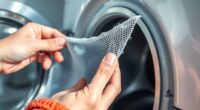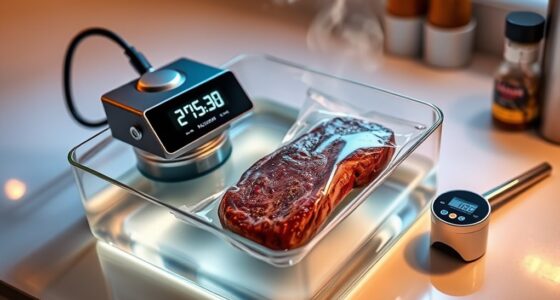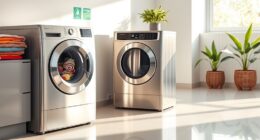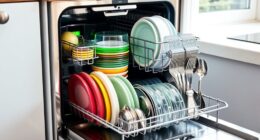To clear ice maker clogs, start by unplugging your unit and emptying the ice bin. Gently remove icy buildup with plastic tools and warm water, avoiding metal objects to prevent damage. Check water lines for mineral deposits and cracks, replacing filters if needed. Regular maintenance can prevent future blockages. For persistent issues, professional help might be necessary. Keep going and you’ll discover more tips to keep your ice maker running smoothly.
Key Takeaways
- Unplug the ice maker, empty the bin, and gather tools before starting the cleanup process.
- Gently chip away ice buildup using plastic tools and warm water to avoid damaging internal parts.
- Clear mineral deposits and ice jams by applying warm water and carefully removing ice chunks.
- Regularly clean the ice bin, replace filters, and check water lines to prevent future clogs.
- Seek professional help if issues persist, such as ongoing flow problems, leaks, or unusual ice production.
Identifying Common Causes of Ice Maker Blockages
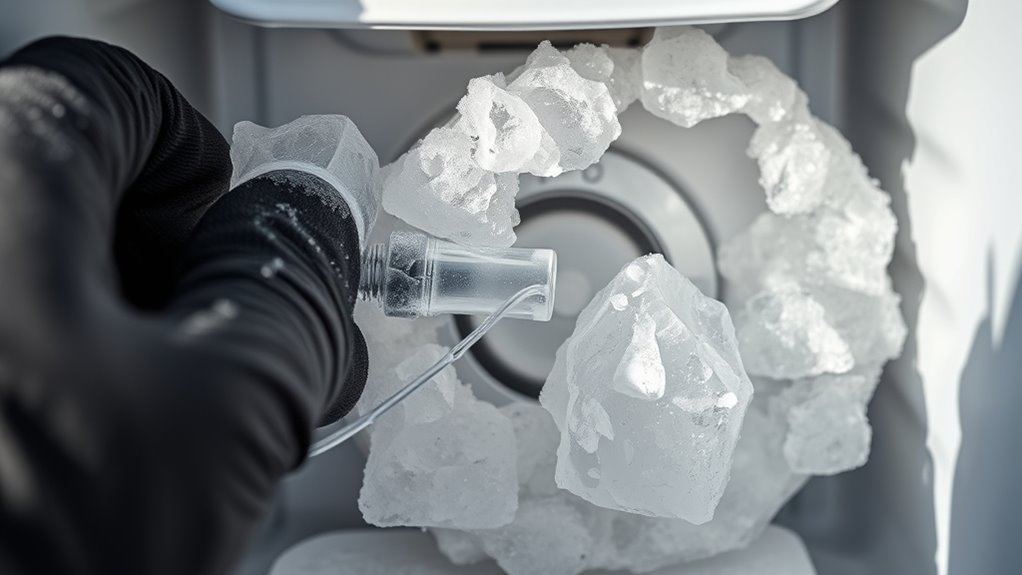
Ice maker blockages often happen because of simple, preventable issues. One common cause is mineral buildup from hard water, which can clog the water inlet valve or freeze into thick deposits inside the ice tray. Another frequent problem is improper maintenance—neglecting regular cleaning allows mold, slime, and debris to accumulate, obstructing the ice production process. Overfilled ice bins can also cause jams, especially if ice gets stuck or refreezes. Additionally, leaks or cracks in the water line can introduce air or dirt, disrupting water flow and leading to clogs. Furthermore, using the wrong type of water filter or neglecting to replace it can reduce water flow, resulting in ice blockages. Regularly inspecting your water supply and understanding industry trends can help you prevent future ice maker problems and maintain optimal marketing strategies for your appliance care routine. Staying informed about appliance maintenance best practices is also essential to keep your ice maker functioning smoothly. Implementing AI-driven diagnostics can provide proactive insights into potential issues before they cause a blockage.
Preparing Your Ice Maker for Clearing
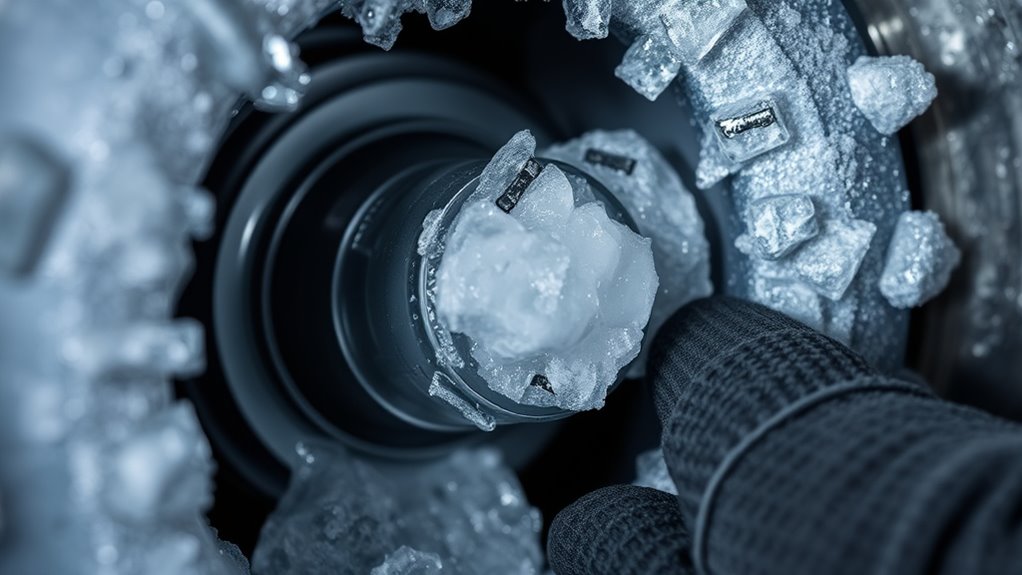
Before you start clearing a clog, it is vital to prepare your ice maker properly. First, unplug the unit to prevent electrical hazards and avoid damage. Second, empty any remaining ice from the bin to prevent it from melting and refreezing during the process. Third, gather necessary tools like a soft cloth, a plastic spatula, and a container for water. Fourth, clear the surrounding area of any obstacles to give yourself easy access. Taking these steps guarantees safety and makes the clearing process smoother. Additionally, understanding the internal components of your ice maker can help you identify potential issues more efficiently. Proper maintenance and troubleshooting can prevent clogging issues in the future. Being familiar with Kia Tuning options can also help you optimize your vehicle’s performance and prevent mechanical problems that could lead to malfunctions. Preparing your ice maker minimizes the risk of accidents and helps you work efficiently. Once everything is set, you’re ready to proceed with removing ice buildup and clearing the clog safely.
Safely Removing Ice Buildup and Clearing the Clog
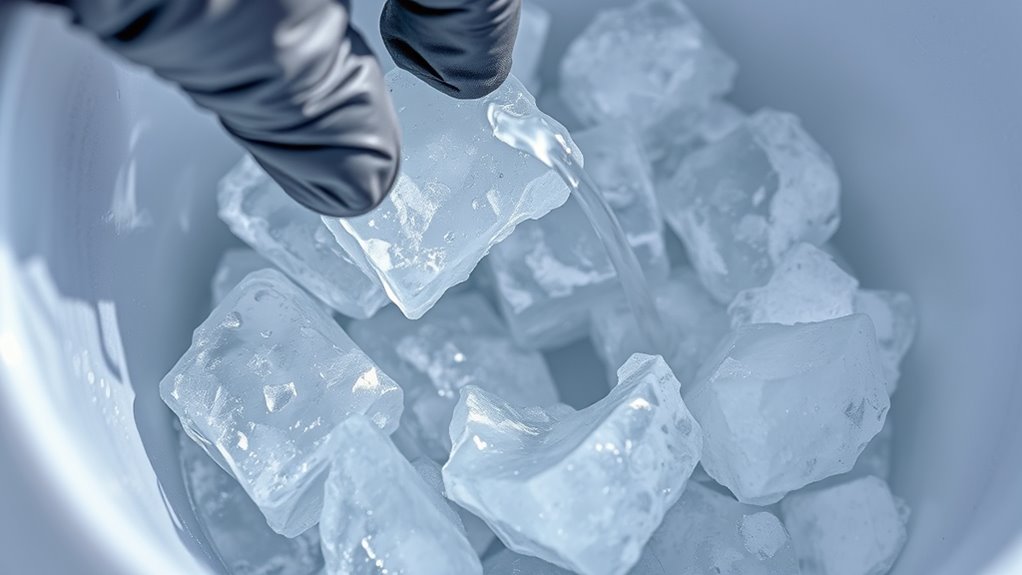
With everything prepared, it’s time to carefully remove the ice buildup causing the clog. Start by turning off the ice maker and unplugging it to prevent any accidents. Use a plastic spatula or a wooden spoon to gently chip away at the ice, avoiding metal tools that could damage the components. If the ice is stubborn, apply warm (not hot) water around the buildup to loosen it. Be cautious not to force anything, as this could cause damage. Once the ice begins to break apart, carefully lift or scoop out the chunks. Keep a towel nearby to catch melting water. Take your time, ensuring you don’t damage any internal parts, and always prioritize safety throughout the process. Regular maintenance and understanding the importance of proper appliance care can help prevent future clogs and extend the lifespan of your ice maker. Additionally, regular cleaning can prevent the buildup of mineral deposits that contribute to ice maker clogs and ensure optimal operation. Being aware of filter replacement and proper usage can also improve your overall experience when connecting devices for maintenance or troubleshooting. Proper drainage is essential to avoid water accumulation and subsequent freezing issues.
Tips to Prevent Future Ice Maker Clogs

To prevent future ice maker clogs, regular maintenance is essential. Keeping your ice maker in top shape reduces the risk of buildup and blockages. Here are four key tips:
Regular maintenance prevents ice maker clogs and extends its lifespan.
- Clean the ice bin regularly to prevent mold and debris from contaminating the ice. This simple step also supports hygienic ice production and prolongs appliance lifespan. Regular cleaning prevents bacterial growth, which can compromise ice quality.
- Replace water filters every six months to ensure clean, debris-free water flows.
- Check and clear the water line periodically to avoid blockages caused by mineral deposits or kinks. Properly maintaining the water line can also prevent clog buildup and ensure consistent ice production.
- Keep the freezer temperature stable between 0-5°F to prevent over-freezing that can cause ice buildup.
- Be aware of your ice maker’s pinball machine weight and installation requirements to avoid unnecessary strain on components, which can contribute to clogs. Additionally, understanding the glycolic acid benefits for skin can help you maintain your appliance’s components if you use glycolic acid-based products nearby, as they may affect the environment of your freezer.
Following these steps helps maintain smooth operation, reduces clogging chances, and extends your ice maker’s lifespan. Consistent upkeep keeps your ice supply clear and trouble-free.
When to Seek Professional Assistance

Sometimes, despite your best efforts, ice maker issues persist or worsen. If you’ve tried clearing clogs, checking filters, and resetting the system without success, it’s time to call a professional. Persistent leaks, unusual noises, or ice that’s oddly shaped or limited in size are signs there might be a deeper mechanical or electrical problem. If water isn’t flowing properly or your ice maker stops producing altogether, a technician can diagnose and fix issues beyond DIY scope. Avoid delaying professional help, as unresolved problems can lead to further damage or water leaks. Trusting an expert guarantees your appliance gets the proper repair and keeps your ice supply reliable and safe.
Frequently Asked Questions
How Often Should I Inspect My Ice Maker for Clogs?
You should examine your ice maker for clogs at least once a month to keep it functioning smoothly. Regular checks help you catch any buildup of ice or debris early, preventing potential issues like water flow problems or ice production delays. If you notice reduced ice output or strange noises, inspect more frequently. Staying proactive ensures your ice maker stays clean, efficient, and ready whenever you need it.
What Tools Are Safest for Clearing Ice Maker Blockages?
When it comes to clearing ice maker blockages, safety’s the name of the game. You should use non-metallic tools like plastic or wooden picks, which won’t damage parts or cause injury. A soft brush or a plastic scraper is perfect for dislodging ice without risking a meltdown. Remember, don’t rush in with sharp objects—patience is key, and using safe tools keeps everything running smoothly without a hitch.
Can Mineral Deposits Cause Frequent Ice Maker Clogs?
Mineral deposits can definitely cause your ice maker to clog more often. When minerals like calcium and magnesium build up in the water lines or the ice mold, they create blockages that restrict water flow. This buildup can lead to frequent clogs and ice production issues. To prevent this, you should regularly clean your ice maker and consider using a water softener, which helps reduce mineral deposits and keeps your machine running smoothly.
Are There Specific Cleaning Agents Recommended for Ice Maker Maintenance?
Imagine your ice maker as a tiny winter wonderland, needing just the right touch to stay pristine. You should use mild, food-safe cleaning agents like diluted vinegar or a commercial ice machine cleaner. These break down mineral buildup and bacteria without harming parts. Avoid harsh chemicals, which can damage your machine or leave residues. Regular cleaning with gentle agents keeps your ice fresh and your machine running smoothly.
How Do I Troubleshoot if My Ice Maker Still Doesn’t Produce Ice After Clearing?
If your ice maker still doesn’t produce ice after clearing clogs, start troubleshooting by checking the water supply. Make sure the water line is connected and turned on. Inspect the water inlet valve for blockages or damage. Also, verify the freezer temperature is cold enough, usually around 0°F (-18°C). If these steps don’t work, reset the appliance or consult a professional for further diagnosis.
Conclusion
Did you know that a clogged ice maker can reduce its efficiency by up to 30%? Regularly clearing ice buildup not only keeps your machine running smoothly but also extends its lifespan. By following these simple DIY steps, you can save money and avoid costly repairs. Stay proactive—your ice maker will thank you with consistent, clean ice whenever you need it! Keep these tips in mind, and enjoy hassle-free ice making for years to come.

